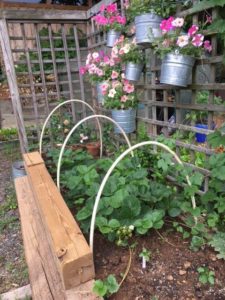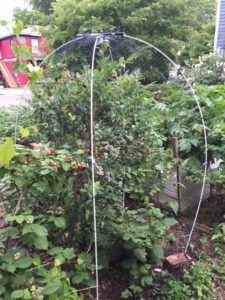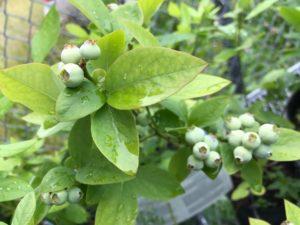-Pam Scott-

“It’s the Berries!”
A phrase hailing back to the 1920’s, expressed by my little grandmother, when something was “super good.” Berries are super good. There is nothing better than standing in the garden on a warm spring morning and eating the first strawberries off the plant. Having planted as many small fruits as I can fit into my small city garden, I have been enjoying a bounteous harvest of strawberries, raspberries, blueberries and grapes for quite a few years. When the harvest comes in, it is almost a full time job to keep up with picking, freezing and canning. I can expect to harvest 4-6 quarts of blueberries, 1-2 quarts of raspberries and 15 pounds of grapes per plant during a season!
Growing berries is one of the simpler of my urban garden adventures, although there are a few important things to know before you plant. Wildlife enjoy berries just as much as you do, so be prepared to protect your berries from birds and squirrels as soon as the plants show fruit. Using thin pvc supports (aka row cover supports here at Fifth Season), you can build a frame for your blueberries and strawberries that can be covered with bird netting. Pull the netting tightly over the supports so that the birds don’t get caught in the net. This can be damaging to our fine feathered freeloaders, which we want to avoid at all costs. Make an opening that has easy access, secured with clips, so that you can pick your fruit without too much fuss.

Blueberries will produce more fruit when you have more than one plant to attract pollinators. I choose early, middle and late bloomers so I can harvest fruit for more than one month.
When planting raspberries and blackberries, remember that next year’s fruits will grow on new canes produced throughout the current summer, so leave plenty of room for new growth, and prune out old canes in early spring. I make sure to always have some fall producing raspberries. It is such a sweet surprise to find ripe berries just when you thought all the fun was over. Raspberries do not last long on the cane, so they must be picked and processed as soon as they ripen. The birds don’t seem to bother as much with raspberries and blackberries; therefore, I don’t net these. I do, however, hang reflective tape from the canes just before berries ripen to scare off the birds.
If planting grapes, it helps to build a strong trellis that the grapes can grow on, to top off and hang down. This makes harvesting easier, and you can net the sides when they begin to ripen. I prune my grapes in January before the sap runs. This ensures no damage to the plant as a result of “bleeding” sap, which is the lifeblood of the vine. We love to pickle the young concord grape leaves before the summer toughens them up. This is a long-enjoyed mediterranean favorite.

I have found that the more nutrient rich my soil is, the better tasting the berries are, especially when it comes to strawberries. I plant June bearing strawberries because they produce a large crop all at once, early in the season, making it great for jam production. The Day Neutral and Everbearing varieties yield less fruit, but they produce throughout the summer and fall. I replant the runners from the June bearing plants for the next year’s strawberries as the mother plant becomes less productive.
When planting your berry garden, prepare your soil ahead of time. Berries enjoy a sandy, loamy, well draining soil, with plenty of organic matter. Have your soil tested for PH and nutrient content. Most fruits enjoy a slightly acidic nutrient rich soil with a PH of 5.8 to 6.5. Blueberries; however, must have a more acidic soil, ranging from a 4.2 to 5.5 PH. When planting blueberries,it is a good idea to amend the soil and adjust the PH six months before planting. A balanced fertilizer applied at the beginning of the growing season, and then again halfway through summer, works well for strawberries, raspberries and grapes. Wait until your blueberries are in the soil for a few weeks before applying an acid loving fertilizer. I like to use Happy Frog’s Marine Cuisine. Remove the first years flowers and fruits from your blueberries, allowing the plant to establish strong root and stem growth, to ensure that the berries do not weight the plant down and to give it a jumpstart for the next growing season.
Heavily mulch all of your fruits with pine bark, shavings, or untreated straw to maintain moisture during the hot summer. This is especially important for strawberry plants. Don’t hesitate to water your new plantings when needed.
With a little planning and picking, you can turn a small garden into a berry lovers paradise. “It’s the Berries!”

Leave a Reply